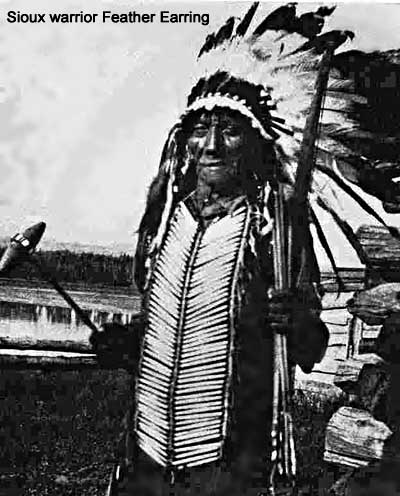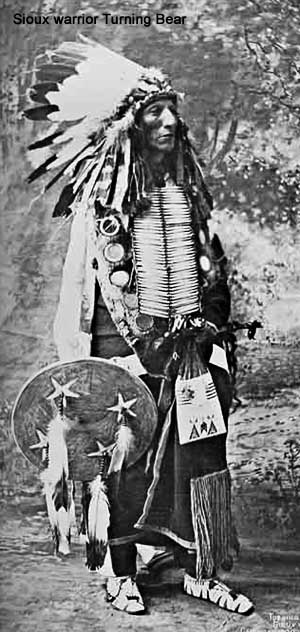|
|||||||
Bruce Brown's 100 Voices... Feather Earring's Story of the Battle
"Feather Earring" saw him signaling that soldiers were coming, calling "one of us got killed -- they are right close behind me." He had no sooner arrived than Reno's command began firing in the tepees. "Feather Earring" was fighting against Reno. His brother was killed there. Reno was driven across the river into the hills and began to dig in the ground. He was fought by the Cheyennes and Ogalallas. It was thought at first that Reno's was Crook's command. War parties went to watch Crook, but he had gone back. Some war parties had gone down the Rosebud and had seen a steamboat and soldiers, but had not come back. Reno left the bottom for the hills because the Indians were surrounding him in the attempt to cut him off from his train. It was thought at first that Reno's command was alone. He was fought by the Cheyennes and Ogalallas. Many came from lower down, but about the time Reno reached the hill, word came that the village was being attacked by Custer below. They then left Reno's front for the lower end of the village, but when they got there from Reno's front, it was all over. Custer struck the Hunkpapas. He did not come across the river. He fired on the village. The Indians had crossed the Greasy Grass Creek (Little Bighorn) above where Custer tried to cross, in great numbers, and cut him off from Reno. They got around behind (east) him. They made their main stand on the ridge where the monument now is; they fought very hard. I had put my brother's body in the bushes and came down where Custer was; the fight was over. I drove five horses across the river; gray horses; they were all wounded and trembling. I saw they were mortally wounded and let them go and went back toward monument ridge. About 200 yards from the river I saw two bodies and went to look at them. One was a dead Indian, the other a white man alongside him. I saw the white man's heart beating and called to a Sioux, "Your grandfather has been killed by that man alongside of him; I don't think he is dead; you had better shoot him." He came up and put an arrow through him; he jumped up and was shot and killed by another arrow; he had been playing dead. There were no other marks on him than the two arrow wounds." Q. What time do you think Custer was killed? A. The women and children had gone out after berries and had gotten back; it must have been about noon. Q. Do you think if Custer had kept his men together and attacked at dawn, he would have succeeded? A. Yes, we would have run away, but we would have come back to attack him. It is a pity Custer did not go into the brush instead of out on that ridge. Q. Why didn't Custer go back toward Reno, rather than away from him? A. He couldn't. He was cut off by large numbers of Indians on that side. If Custer had come up and talked with us, we had all agreed we would have surrendered and gone in with him. Q. How many Sioux were killed there? A. There were sixteen that I can name now. Four of these were near Reno, and three were Cheyennes. There were a terrible number wounded. Q. Where were they buried? A. On platforms in the village. Q. What made you leave Greasy Grass Creek? A. A man came back and said many soldiers were coming up Little Bighorn, and were digging holes in the ground. We didn't want to fight them when they dug holes. Q. Where did you go? A. We went toward the Bighorn Mountains, up "Bird Timber" Creek, 20 miles, then 20 miles next day. We got ready to fight Terry's command near the second flat; then we heard they had all gone back.
A. His name was Old She Bear who was wounded in the fight on the Rosebud (Crook). He was a brother of Turning Bear, an Ita-zip-cha. The village was right there where that lodge was on Reno Creek when they fought Crook. They went over to the Rosebud to fight and came back. Old She Bear was shot through both hips, and died in that camp on Reno Creek. The body was put on a scaffold and the lodge pitched over him. Q. Who got a good reputation at that fight? A. All: Crazy Horse, Sitting Bull and all that I heard of. Q. We heard Sitting Bull had run away and was not in the fight. A. I heard him giving orders. While we were up near the Bighorn Mountains we heard that some soldiers had gone into the Bighorn Mountains, where they dismounted and tied their horses in the timber. The Cheyennes brought back a number of their horses. We did not see the soldiers. After the Terry command went away, we came back down Greasy Grass Creek crossed over where Custer attempted it, up Custer Creek, and then over to the Rosebud. Q. How many Indians were killed in Crook's fight? A. Four. Many were wounded. Q. How many lodges were there? A. There were very many; three or four young men in a lodge. We gave each man a willow stick in order to count them. I know we counted over 5,000, and they were not all there; many were over on Arrow Creek stealing horses from the Crows. The Custer Myth: A Source Book of Custerania, written and compiled by Colonel W.A. Graham, The Stackpole Co., Harrisburg, PA 1953, p 103 - 107
Most other eye-witnesses said the names of the two young Sioux who were looking for a horse on the morning of June 25, 1876 were Deeds and Brown Back, not Two Bear and Lone Dog as Feather Earring says here. According to Lazy White Bull, the boy Deeds was the first Sioux killed in the battle, and his father Brown Ass was the one who rushed back to the village with news that the American soldiers were attacking. However, Drags The Rope, who actually witnessed the U.S. Army's murder of Deeds as a young boy on June 25, 1876, said that Brown Back (AKA Brown Ass) was Deeds's older brother, not his father. |
|||||||














